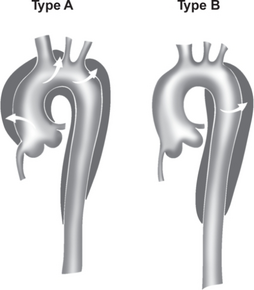11. Diseases of the aorta. Imaging methods, the role of CT and MRI.
Acute aortic syndrome
Acute aortic syndrome (AAS) is a clinical syndrome caused by one of three life-threatening aortic pathologies which all have similar clinical features. These are:
- Aortic dissection (70-80% of cases)
- Aortic intramural haemotoma
- Penetratic aortic ulcer
Clinical features
Patients usually present with severe chest pain that has a tearing character. There is often hypertension.
Aortic dissection
See aortic dissection.
Aortic intramural haematoma
Aortic intramural haematoma refers to the acute formation of a contained haemorrage in the aortic wall. The haemorrhage usually arises from the vasa vasorum. Etiology and treatment is similar as for aortic dissection.
Penetrating aortic ulcer
Penetrating aortic ulcer refers to the formation of an atherosclerotic lesion in the aorta which has ulcerated through the tunica intima. As they progress, they may ulcerate into the tunica media, forming an intramural haematoma. Etiology and treatment is similar as for aortic dissection.
Aortic dissection
Aortic dissection refers to the arterial dissection of the aorta and is, like aortic aneurysm, mostly a disease of older men. It’s a quite deadly condition, with high mortality rate even with treatment. It's one form of acute aortic syndrome.
Classification

Two classification systems exist for aortic dissections, the Stanford classifications and DeBakey classifications, but the Stanford classification is the one which is used. Stanford type A aortic dissection originates from the ascending aorta and may extend all the way to the iliac bifurcation. Stanford type B aortic dissection originates from the beginning of the descending aorta and may also extend to the bifurcation. Stanford type A is the worst type.
Diagnosis and evaluation
Chest x-ray may be the initial evaluation and may show widened mediastinum and irregular contour of the aorta.
The gold standard is CT angiography. Visualisation of two lumen separated by an intimal dissection flap gives the diagnosis. The true lumen is often the smaller of the two. The true and false lumen can also be distinguished based on that the great arteries (coeliac trunk, SMA) usually originate from the true lumen. Echocardiography should always be performed to look for cardiac complications.
